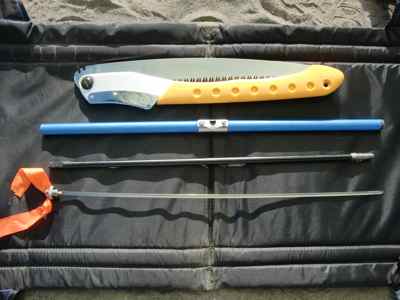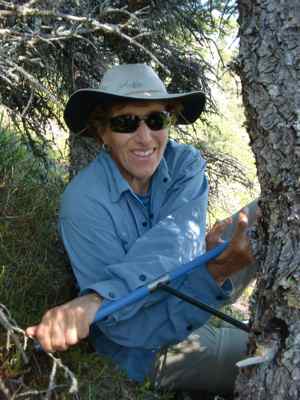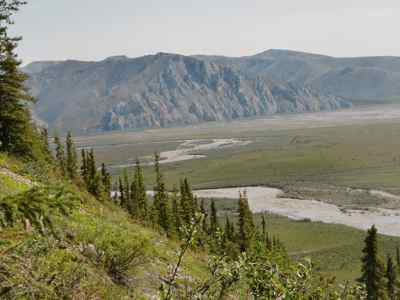After a day spent drilling holes in White Spruce and extracting cores, I can honestly say that coring is not boring. Our plan for the day was to explore the slopes across from our camp, taking samples from trees on two different slopes. We had a sumptuous breakfast of instant oatmeal with fruit and nuts plus the caffeinated beverages of our choice (I'm a tea drinker, Kevin and Angie are coffee people--what does that say about each of us??). After breakfast we packed up and set off for the day with our daypacks loaded with tools, water, snacks, and extra clothing. Don't forget the DEET and bear spray, as well!

Getting to the site involved crossing the braided channels of Mancha Creek a couple of times, followed by a little slogging through a marshy area. So much for dry feet today! Once we climbed up out of the bog, the ground dried out and the tundra vegetation was almost crunchy. The hillsides are covered with small White Spruce--the subject of our coring expedition.
I'm usually a fairly quiet hiker back home in Colorado. But here, it pays to be noisy. As we walked, we took turns yelling out 'Hey Bear' or 'Yo Bear', or sometimes 'Yogi Bear' for a little variety. You certainly don't want to surprise a grizzly. So far we have seen only some older tracks as well as a hillside that had been dug out by a bear in search of a nice meal of ground squirrels.
First, we had to learn the fine art of coring trees. The tools are simple-- I had already had my first lesson when I visited Kevin at the Lamont Doherty Earth ObservatoryA location used for observing terrestrial and/or celestial events. back in April, but Angie was new to this field, and I needed a refresher course. There are two tools used to collect our samples. We use an increment borer to drill a small hole in the tree to extract a core. We also carry a small, folding saw to cut off some of the lower dead branches so that we can access the trunk close to the ground. The process is pretty basic. The handle of the borer is hollow, and holds the drill as well as the 'spoon', the piece that is inserted to pull out a core. The drill fits through the handle and you push hard against the tree while turning the handle to get the drill to catch and core into the tree. It sounds easy, but sometimes it takes a bit of wrestling and contortions just to reach the tree trunk. At times you feel like you're doing a bit of dendro-yoga. Once you've drilled at least halfway into the tree, you insert the spoon into the hollow drill and give the drill a couple turns to the left (remember, righty tighty, lefty loosy) to release the core. Then, you pull out the spoon and inspect your work. Cores are stored inside plastic straws that are marked with the site name and the sample number. We took 2 cores from each tree, and 20 samples from each site. So that was 80 core samples for today. That's a lot of drilling on a hot day with mosquitoes buzzing around your head!

While the equipment and techniques are simple, the samples we collect can be used to answer some complex questions. It goes far beyond figuring out how old the trees are. We're here to see how the growth of these northernmost forests are responding to the temperature increases from climate change. Are longer growing seasons changing the variables that are important for growth? That is, will the White Spruce grow faster, or bigger, as the climate changes or will they reach some limit where other factors will become more important and inhibit their growth? Samples were last collected in this area in 2002, so the work we are doing will extend the tree ring data bank and give insights into changing growth patterns.

There was plenty of time to look around as we took turns coring and storing each sample. The scenery is outstanding--the scale is enormous. It's hard to actually judge how far away some of the mountains are because the scale is so large. It is a landscape of massive proportions. As we kept saying all day, "The work is good and the view ain't so bad either".



Comments